Setting a new model for the sustainable transformation of a large post-industrial site
Baoshan Steel Park
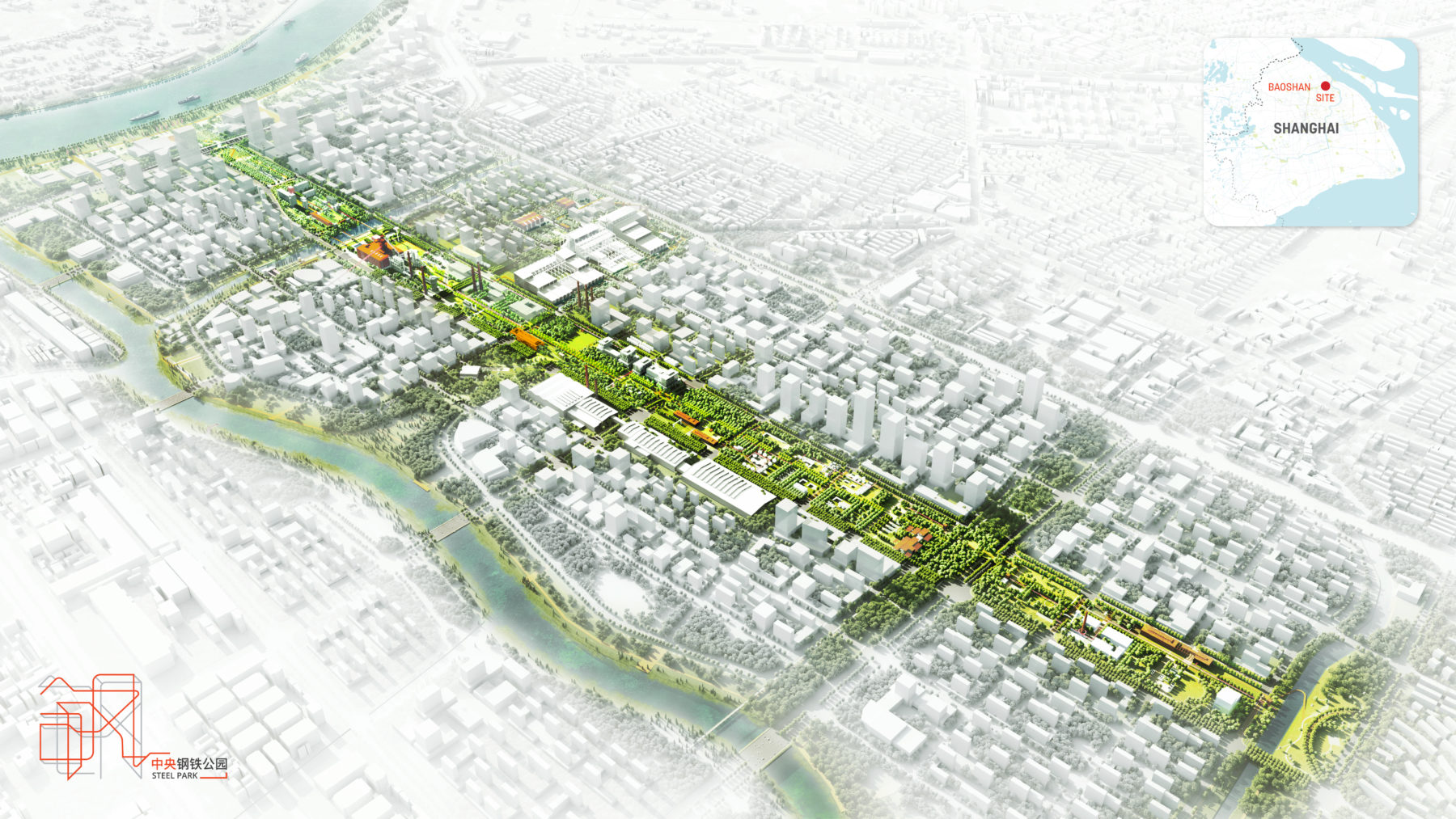
The park is positioned as an urban green axis of Wusong Innovation District, serving the prospective creative industries as well as existing communities in the surrounding neighborhood.
Baoshan Steel Park, which will be implemented over the next 35 years, sets a new model for the sustainable transformation of a large post-industrial site. By restoring the site’s environmental value, preserving its unique culture, and creating a main urban axis, the plan proposes an adaptive landscape which will transform an enclosed steel production place into a growing green artery, preserving its memory while embracing the future.
The spatial structure of the park builds upon the site’s fabric and historical manufacturing processes of the Baoshan Stainless Steel plant. Diverse programs in the park, integrated with the industrial features and made universally accessible, will complement planned uses in adjacent developments as well as the existing communities in the district, offering equal opportunities to all groups of people.
The plan aims to become a full spectrum demonstration of sustainable planning and design, exemplifying the project’s environmental, social, and economic values. Phased implementation couples the progress of eco-restoration and the development in the district, supporting an efficient and effective regeneration process.
Site Evolution
The 102-hectare Baoshan Steel Park is located at the site of the former Baoshan Stainless Steel Plant, a protected historical site in Shanghai representing the national industry of China. The steel plant, which began as Wusong Steelmaking Workshop in 1938, has evolved over 80 years and created many firsts in China’s steelmaking industry, including the first ironmaking furnace in Shanghai in 1959, the first carbon steel manufacturer in 2004, the largest stainless-steel plant since 2006, and in 2010, the world’s first joint production line of ironmaking, steelmaking, hot rolling, and cold rolling. With pressure mounting to reduce air pollution and reclaim industrial land for civic uses in Shanghai, the plant closed in 2018, leaving behind large quantities of heavy equipment and extensive brownfields. This historic industrial site is ready to start a new chapter.
As part of the future Wusong Innovation District, a new sub-center in northern Shanghai, the site is positioned as the district’s urban green axis, serving the prospective creative industries as well as existing communities in the surrounding neighborhood.
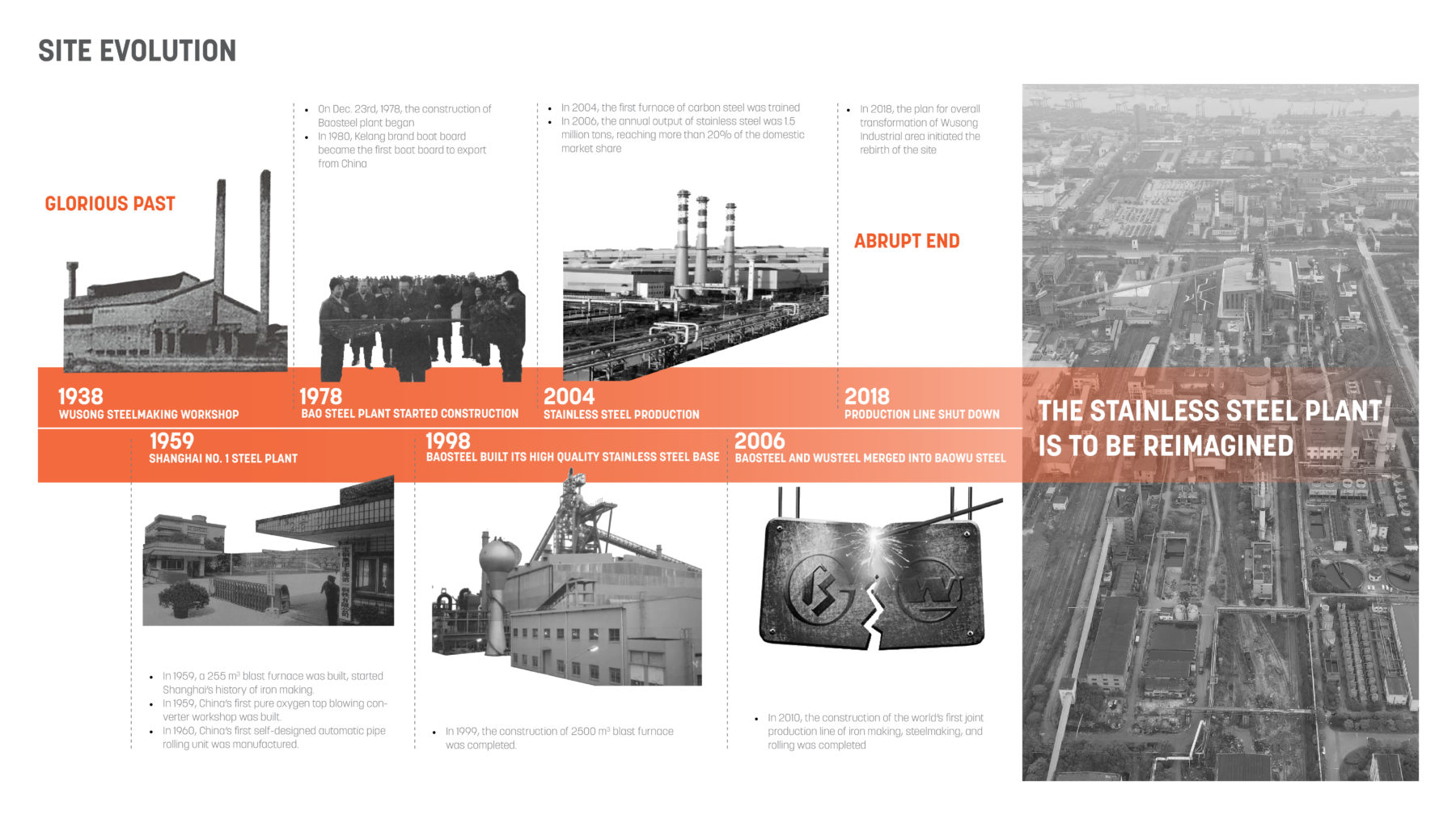
Located in a historical neighborhood representing the national industry of China, the site is now occupied by large quantities of abandoned equipment, extensive brownfields, fragmented green patches of monoculture, and surrounded by low-income communities.
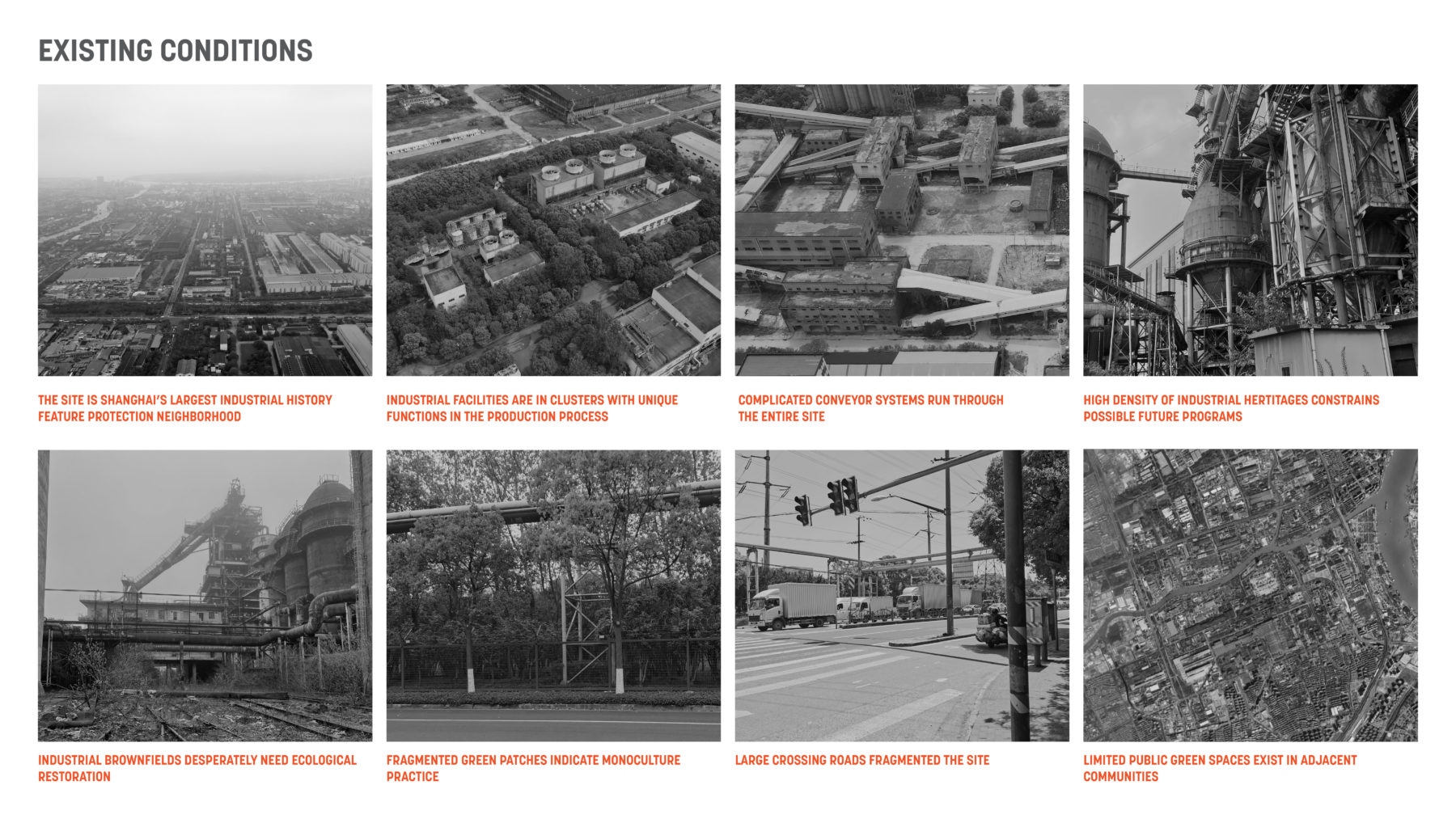
A Growing Green Artery – a Transformative Plan of a Former Heavy Industry Site
The design proposes an adaptive landscape which will transform an enclosed steel production place into a growing green artery.
The reimagined steel park builds its spatial structure upon the original manufacturing processes and site fabric. Major pedestrian paths transformed from on-ground and elevated conveyor systems, (called the Steel Path and Steel Journeys) link the parks’ six themed zones (the Steel Gardens) which follow the original six production clusters. Steel Catalysts, a set of key public buildings repurposed from existing structures, anchor the programs in each garden at the Steel Platform, which links the park’s north and south perimeters.
The park intends to grow over time while onsite phytoremediation and plant succession take place, building a major green infrastructure and a variety of urban habitats. The phasing of the proposed redevelopments will be coupled with the progress of the park construction, to catalyze the new district and create an integrated urban destination.
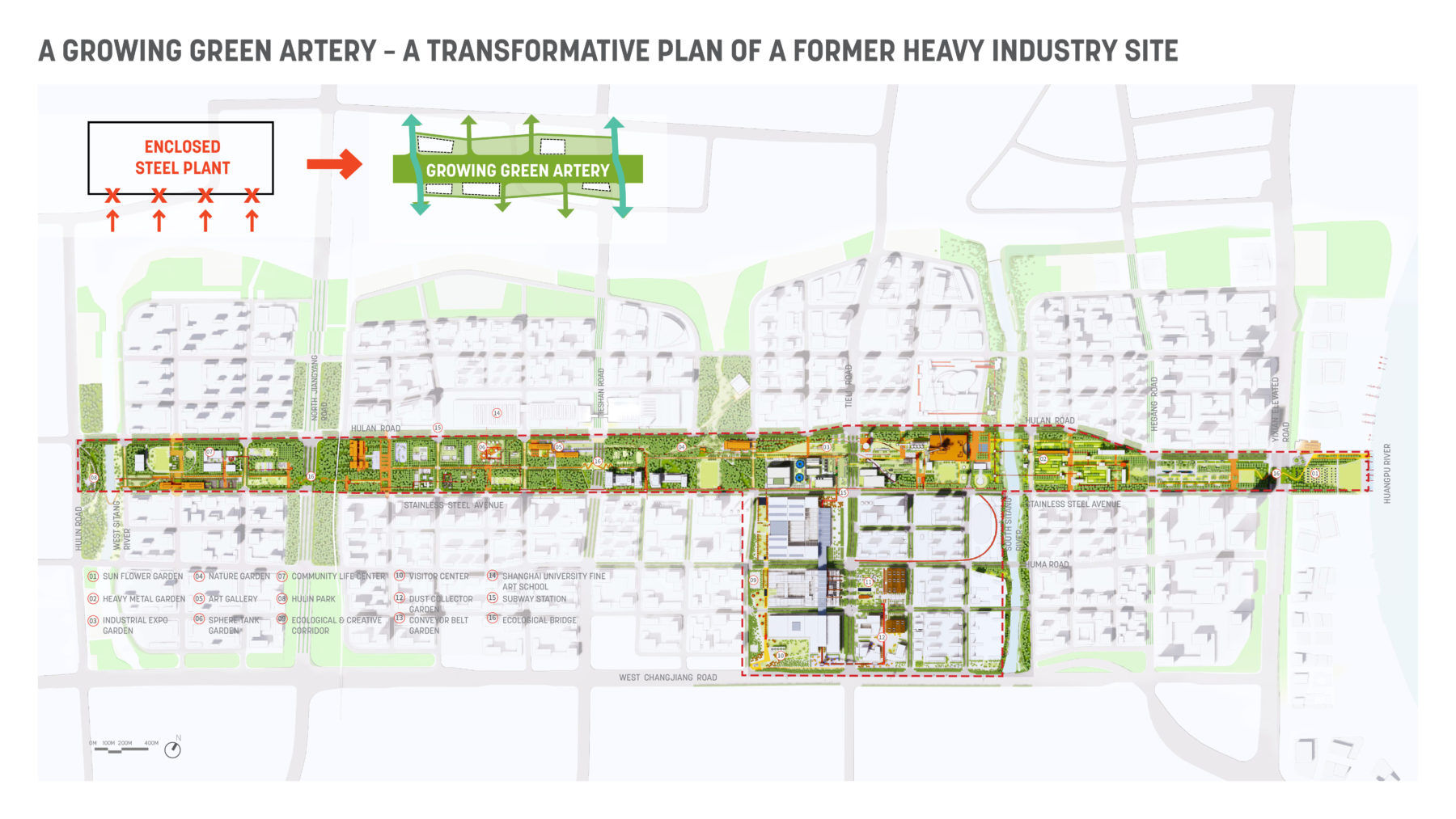
An adaptive landscape is planned for the site which will transform an enclosed steel production facility into a growing green artery.
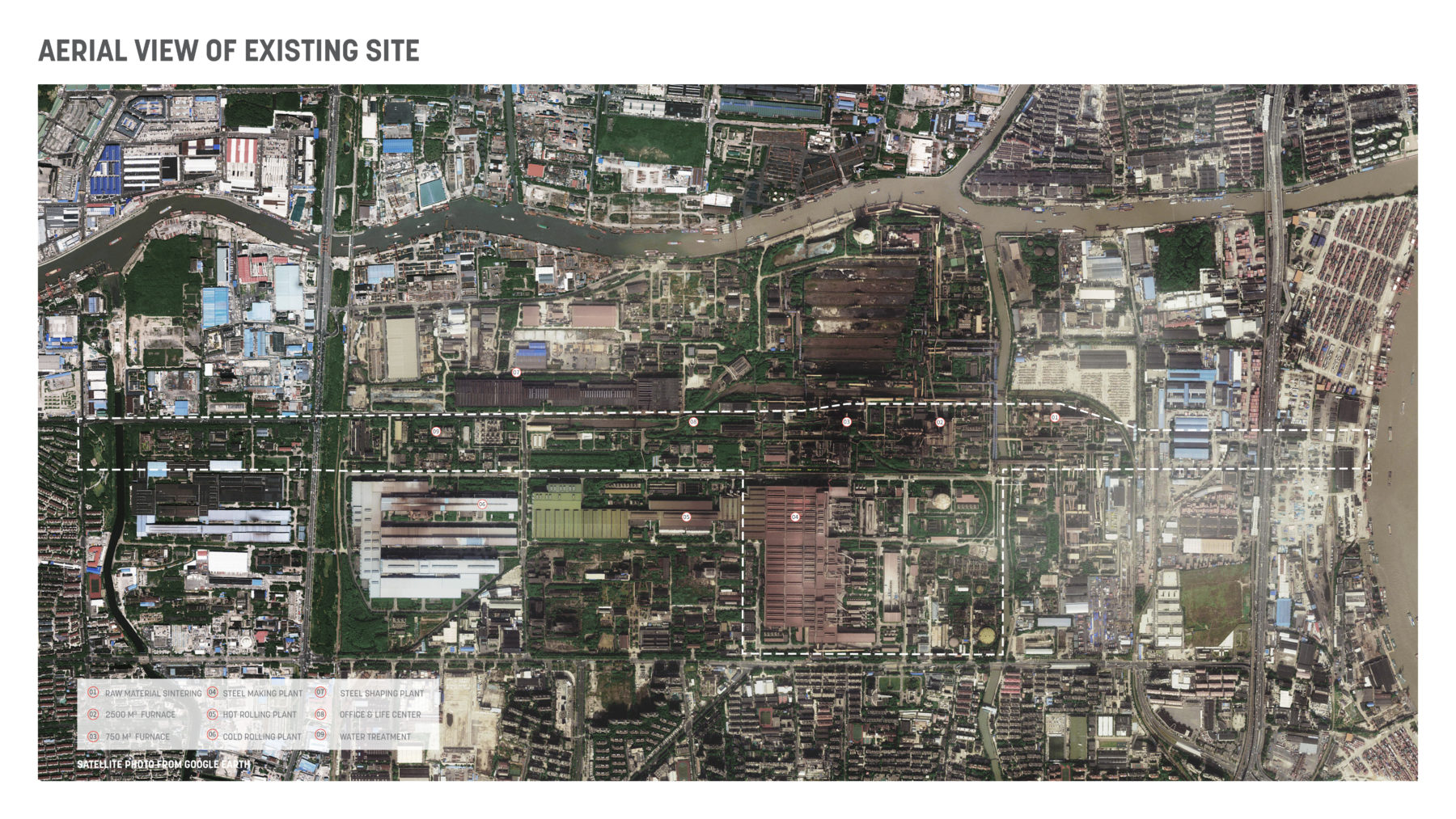
Demonstration of Sustainable Planning and Design
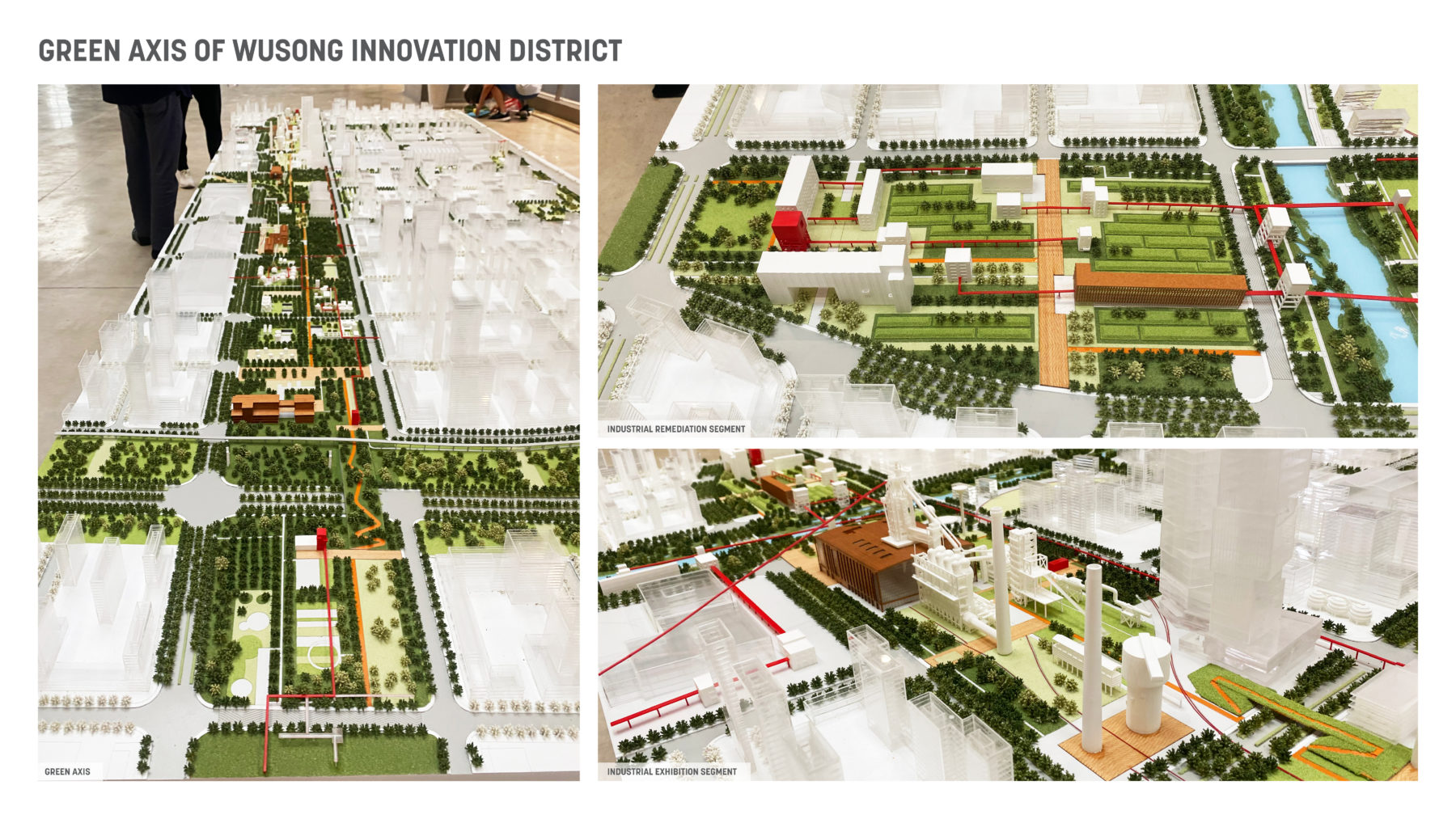
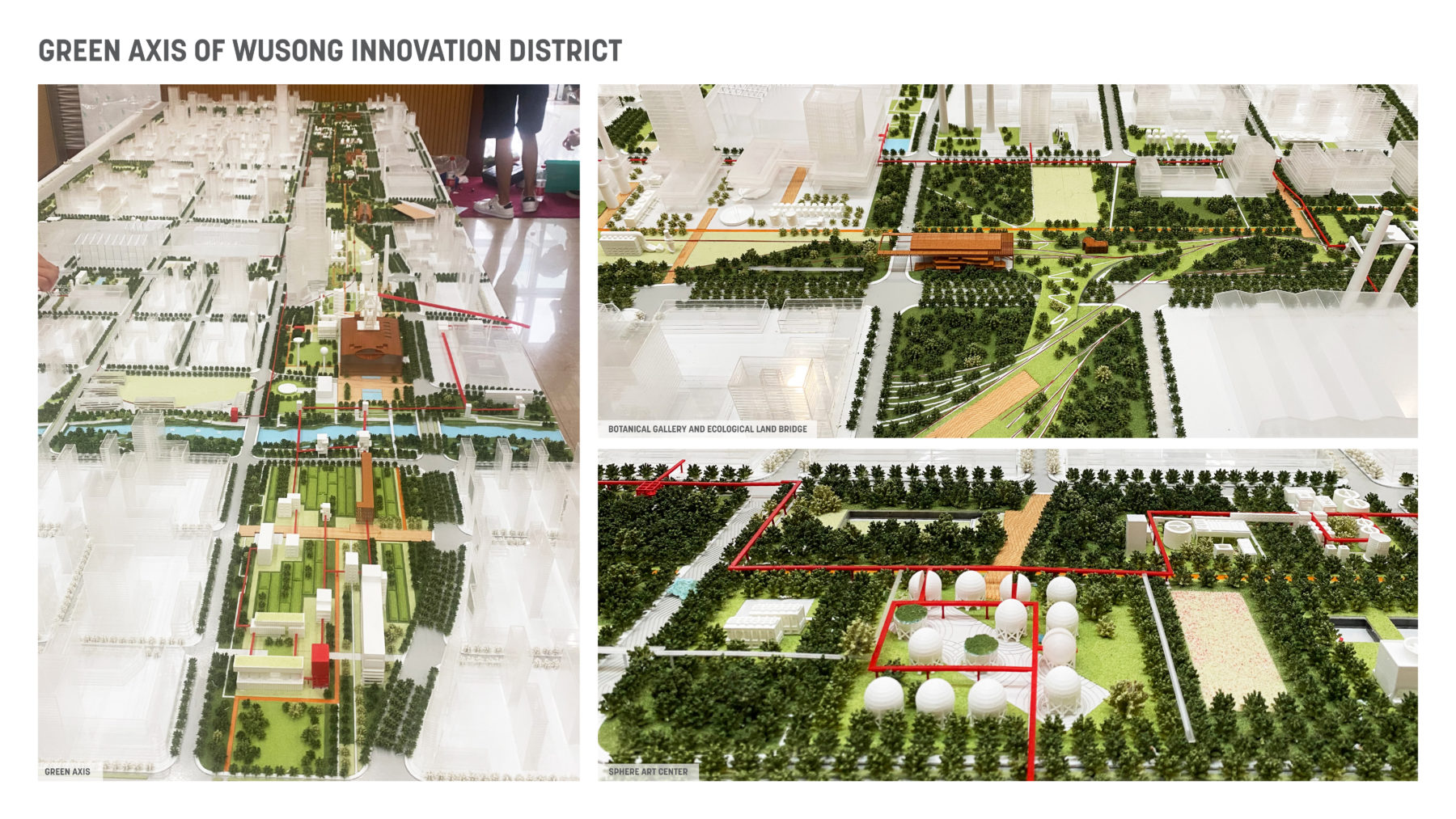
Three major strategies are adapted in the park planning process.
Restore site’s environmental value to create a green infrastructure for the new district
- Decontaminate the site. The existing soil and groundwater had been contaminated to various degrees. The plan will remove heavily contaminated soil and remediate off-site, concentrate moderately contaminated soil to remediate at hyper-accumulator gardens onsite, and remediate lightly polluted soil in place with hyper-accumulator plants.
- Create habitat. The monoculture of the fragmented existing green patches and the hard edge of the canals provide very limited ecological value. The plan restores near-natural forest, grows continuous woodland, restores wetland along the riverfront, and builds land bridges to link ecological corridors, to create a regional ecological network and diverse urban habitats for mammals, reptiles, birds, amphibians, and invertebrates.
- Create urban carbon sink. The park will contribute an important carbon sink to the city. Vegetation in the park will sequester over 7,000 tons of carbon emissions per year, exceeding the amount of annual emission from the traffic over the perimeter and crossing streets of the park.
- Manage stormwater. Rain gardens, bio-swales, and permeable paving will be integrated along all public streets and inside the park, and wetlands will replace the hard-edged existing waterfronts, to detain over 16,000 m3 of stormwater on site, reaching 85% total control rate of the annual runoff. The collected rainwater can be reused as water sources for water features, fire hydrants, road cleaning, etc.
- Improve wind and thermal environment. The park will work not only as an urban cold island, but also as a regional ventilation corridor from Huangpu River to the inland, reducing temperature in the surrounding neighborhood by one to three degrees Celsius. The plan orients park spaces to welcome prevailing wind in summer, and block wind in winter with the help of evergreen trees, creating a comfortable microclimate and prolonging the outdoor season.
- Achieve energy self-sufficiency. The existing buildings, roads, equipment, and site structures will be repurposed for park uses to minimize embedded energy. Solar power harvested through the integrated photovoltaic membranes on site structures will cover the annual electricity usage of site lighting completely, with 25% surplus to return to the grid. All buildings in the park are to operate in a net-zero model.
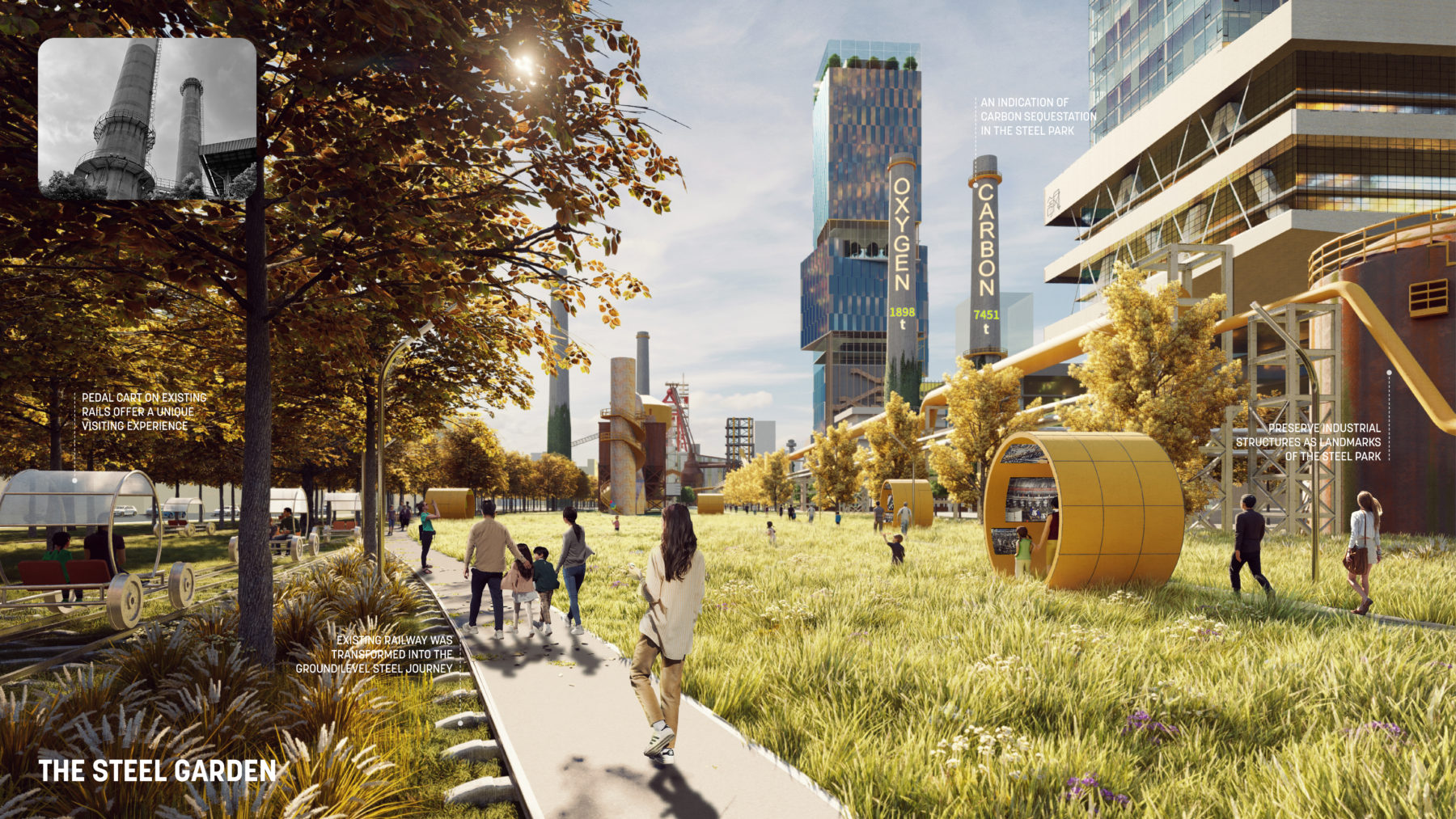
The Steel Garden
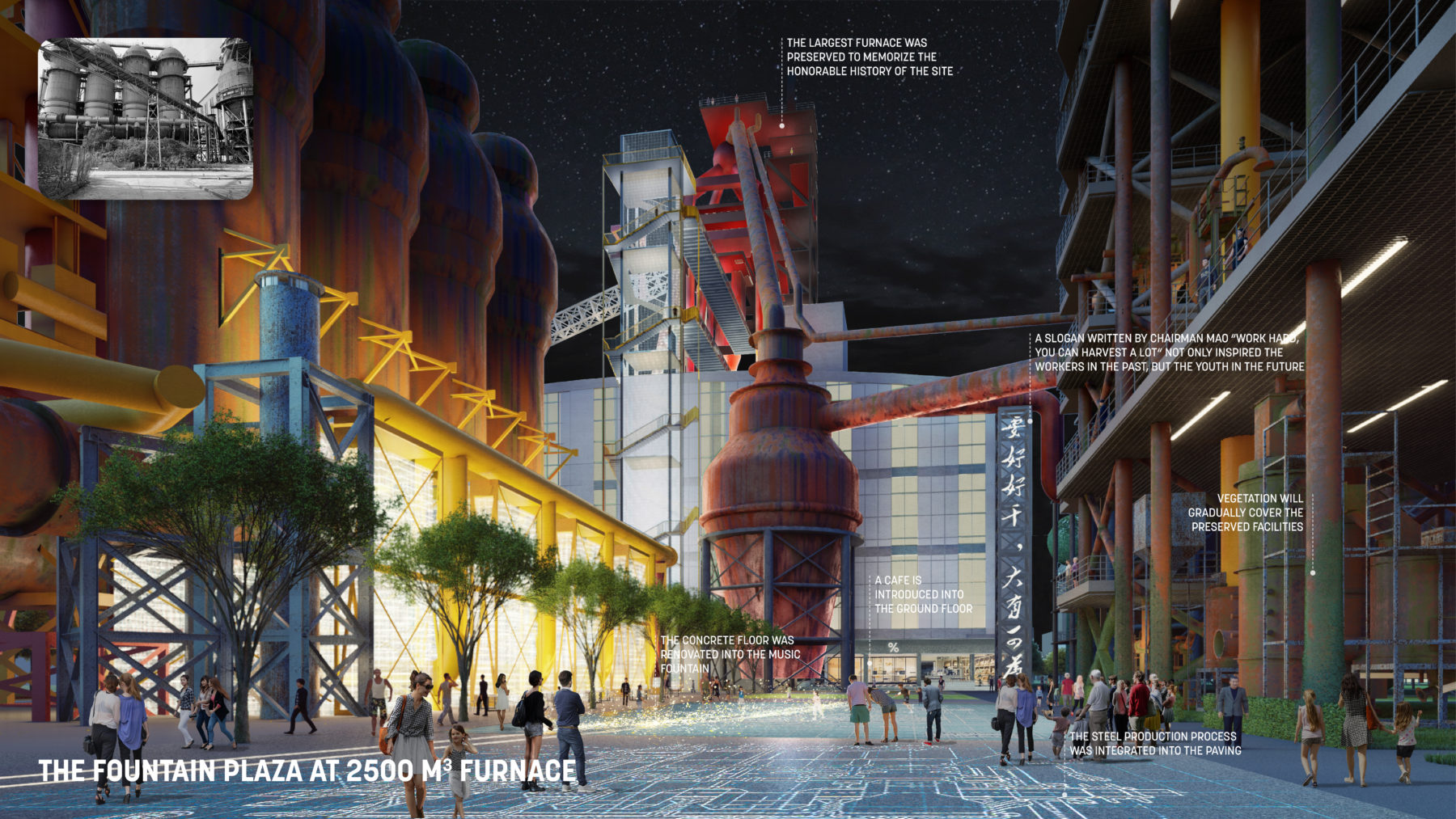
The Fountain Plaza at 2500 M³ Furnace
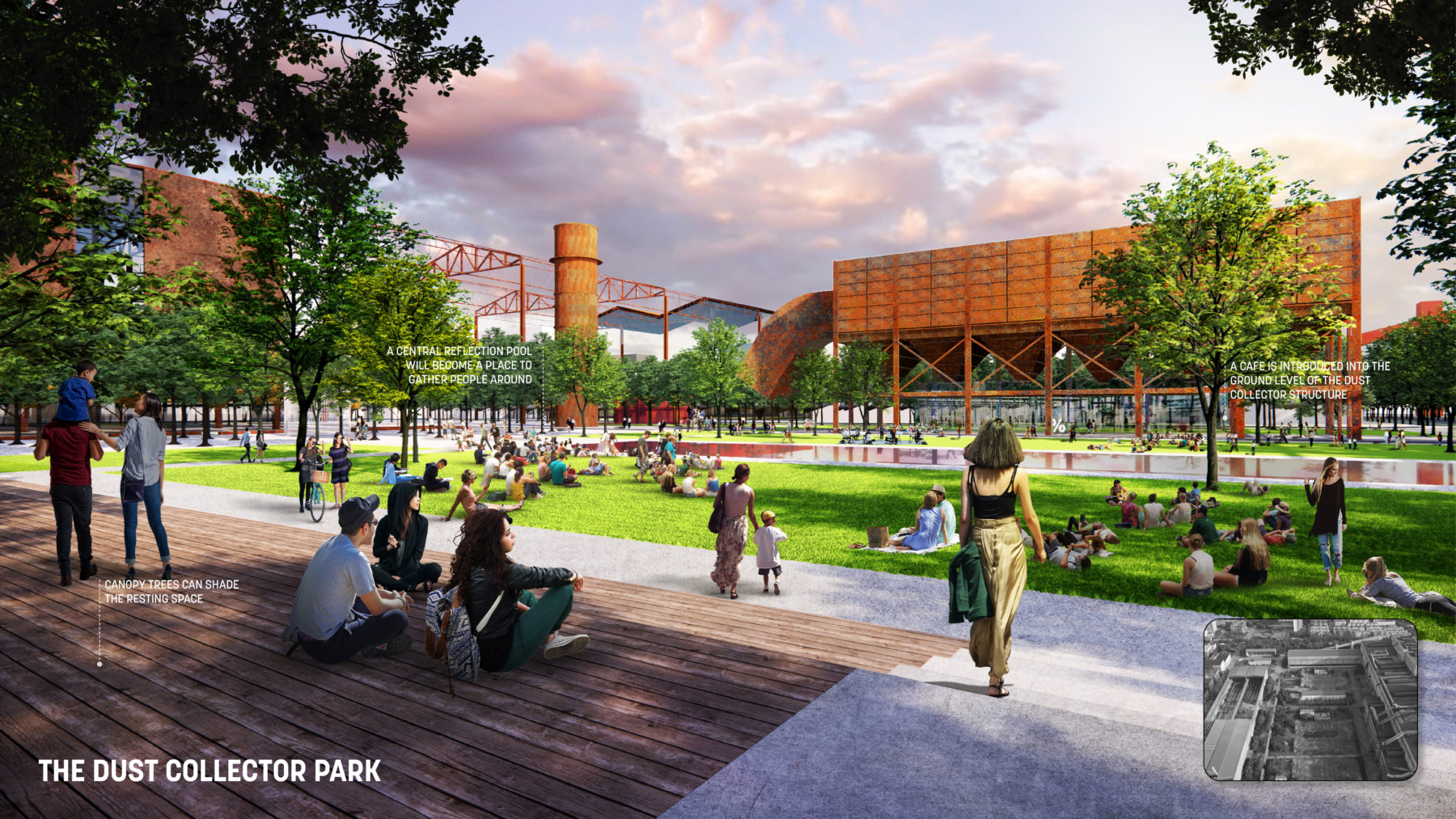
The Dust Collector Park
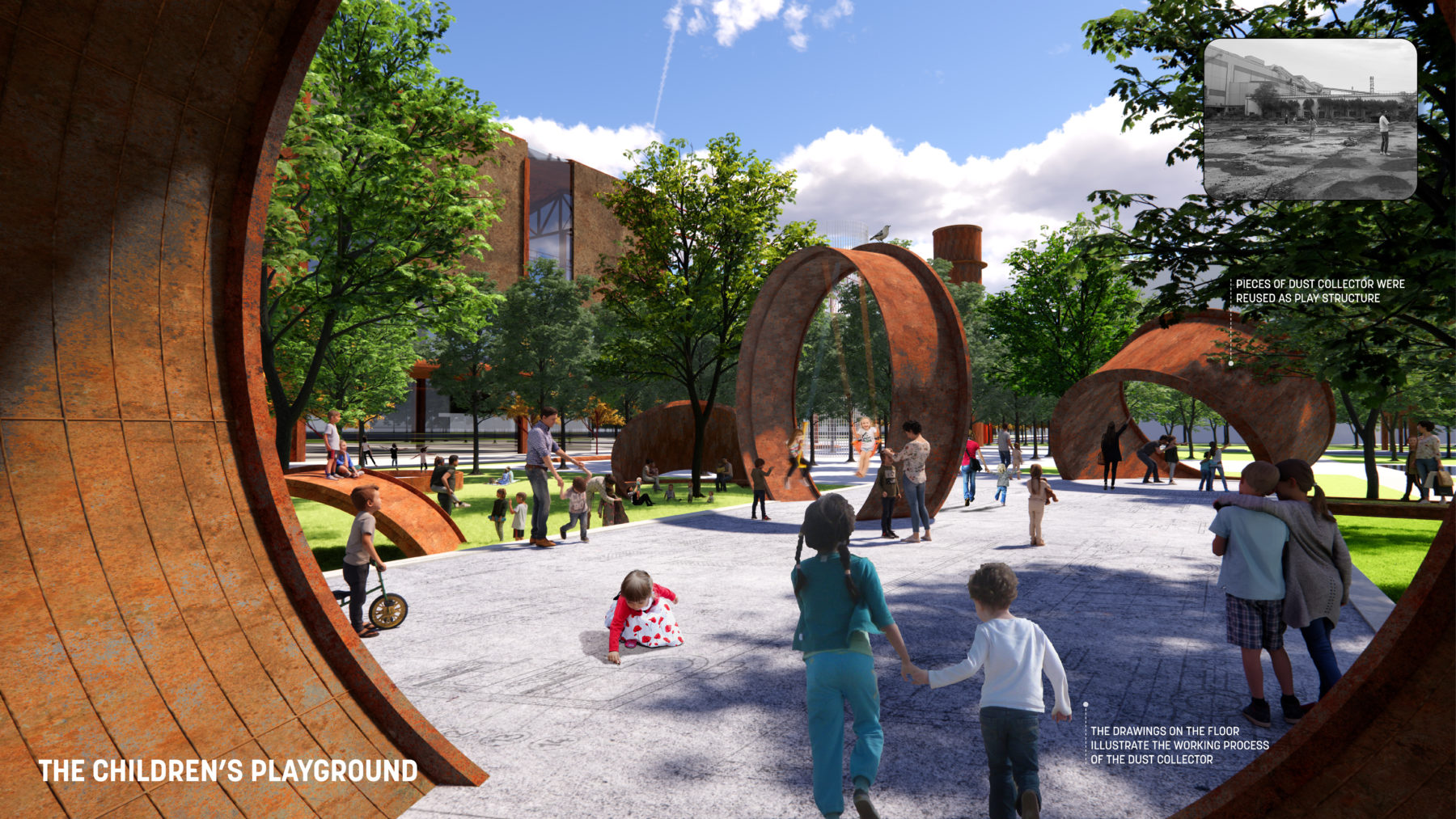
The Children’s Playground
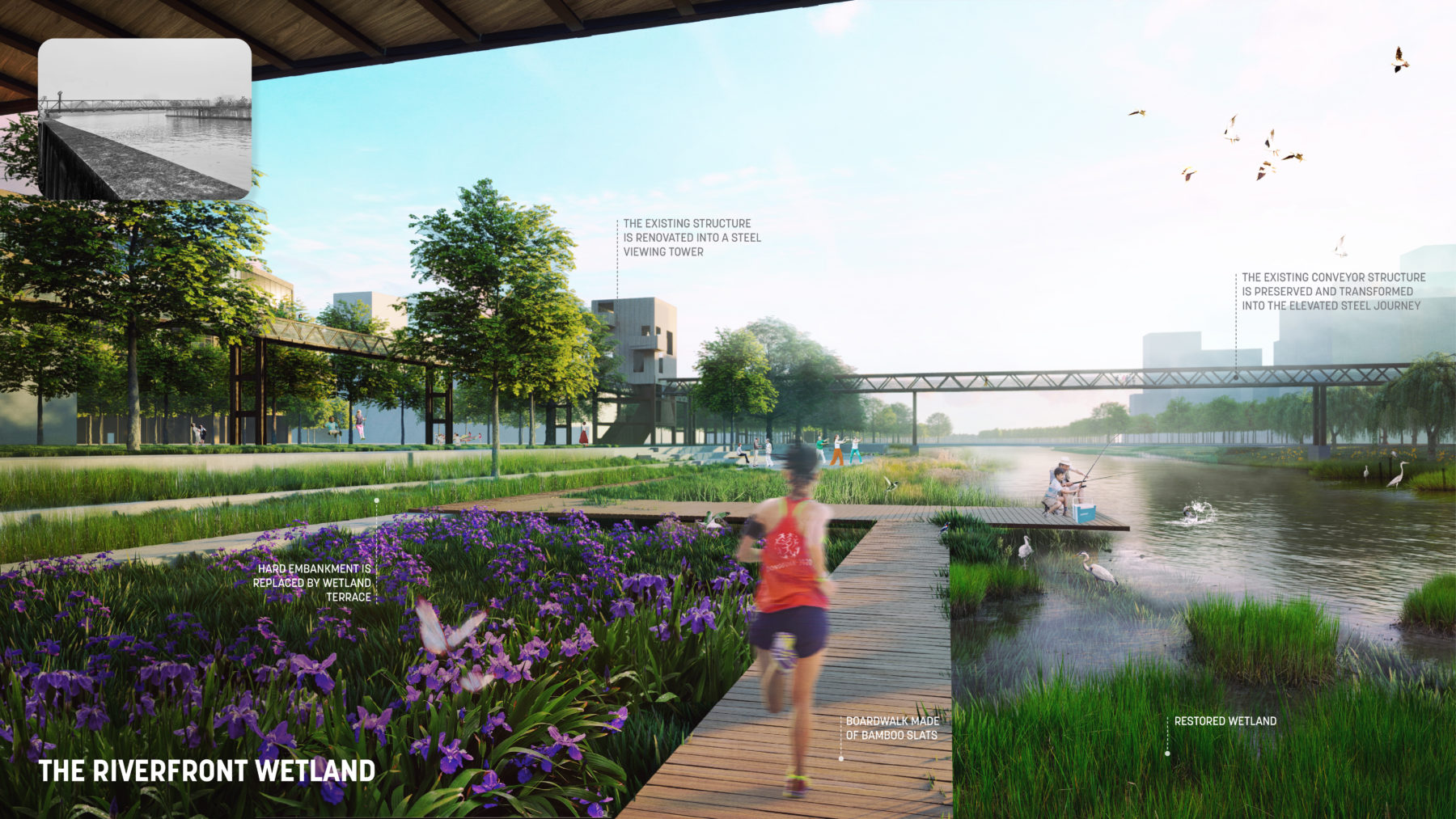
The Riverfront Wetland
The Steel Garden
The Fountain Plaza at 2500 M³ Furnace
The Dust Collector Park
The Children’s Playground
The Riverfront Wetland
Preserve the unique culture to create a reimagined steel park
- Activate industrial remnants. Based on the district master plan and characteristics of the existing industrial equipment and facilities, the plan preserves all the industrial history to the greatest extent possible and proposes new uses and ways of transformation. The main service road will be preserved and converted into the main path through the park, the Steel Path; the network of internal railroads and conveyors will be turned into Steel Journeys punctuated by Steel Viewing Towers, providing a ground and elevated industrial tour. The medium-sized factory buildings will be renovated to Steel Catalysts, creating major public destinations in the park, while large factory buildings converted to Super Workshops holding various innovation industries; and the manufacturing clusters are to be transformed into six program zones, the Steel Gardens.
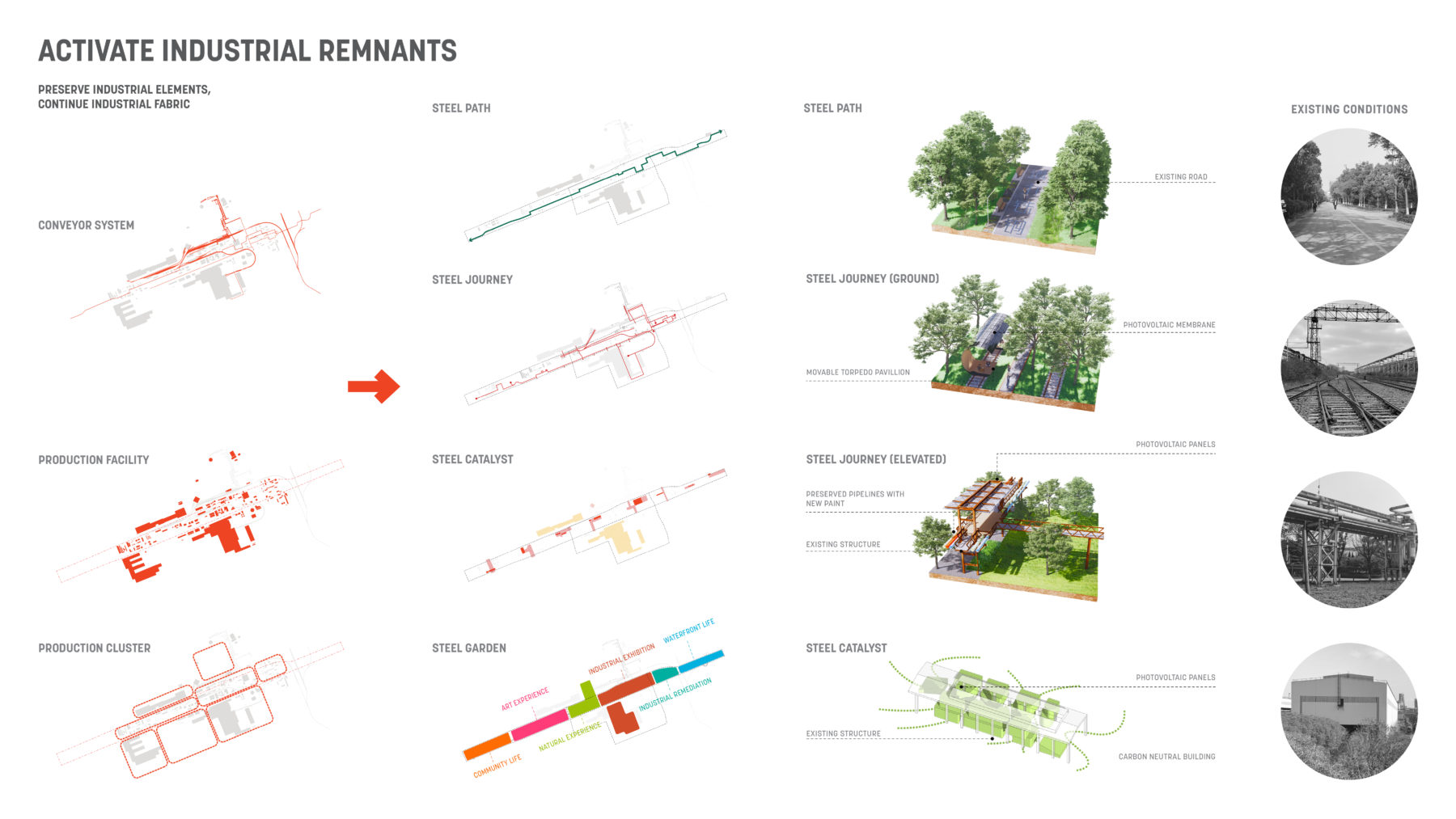
- Provide programs for all groups of people. Diverse programs in the park, integrated with the industrial features and made universally accessible, will complement planned uses in adjacent developments and the existing communities in the district, offering equal opportunities to all groups of people. Six unique Steel Gardens together compose a coherent steel park. The Community Life turns the former tin-plated steel cluster into a vigorous community place. The Art Experience transforms the compartment yards of the wastewater treatment cluster into a series of art gardens in a collaboration with nearby Shanghai University School of Fine Art. The Nature Experience restores existing nurseries to near-natural forest in the post-industrial site. The Industry Showcase preserves the complete set of ironmaking equipment as an exhibit of the site’s past glory, while the Industry Remediation Garden in the most-polluted sintering area demonstrates the state-of-the-art phytoremediation technology. The Waterfront Life Garden turns the hard-surfaced container port into a green space celebrating renewable energy and sustainable lifestyles along Huangpu River.
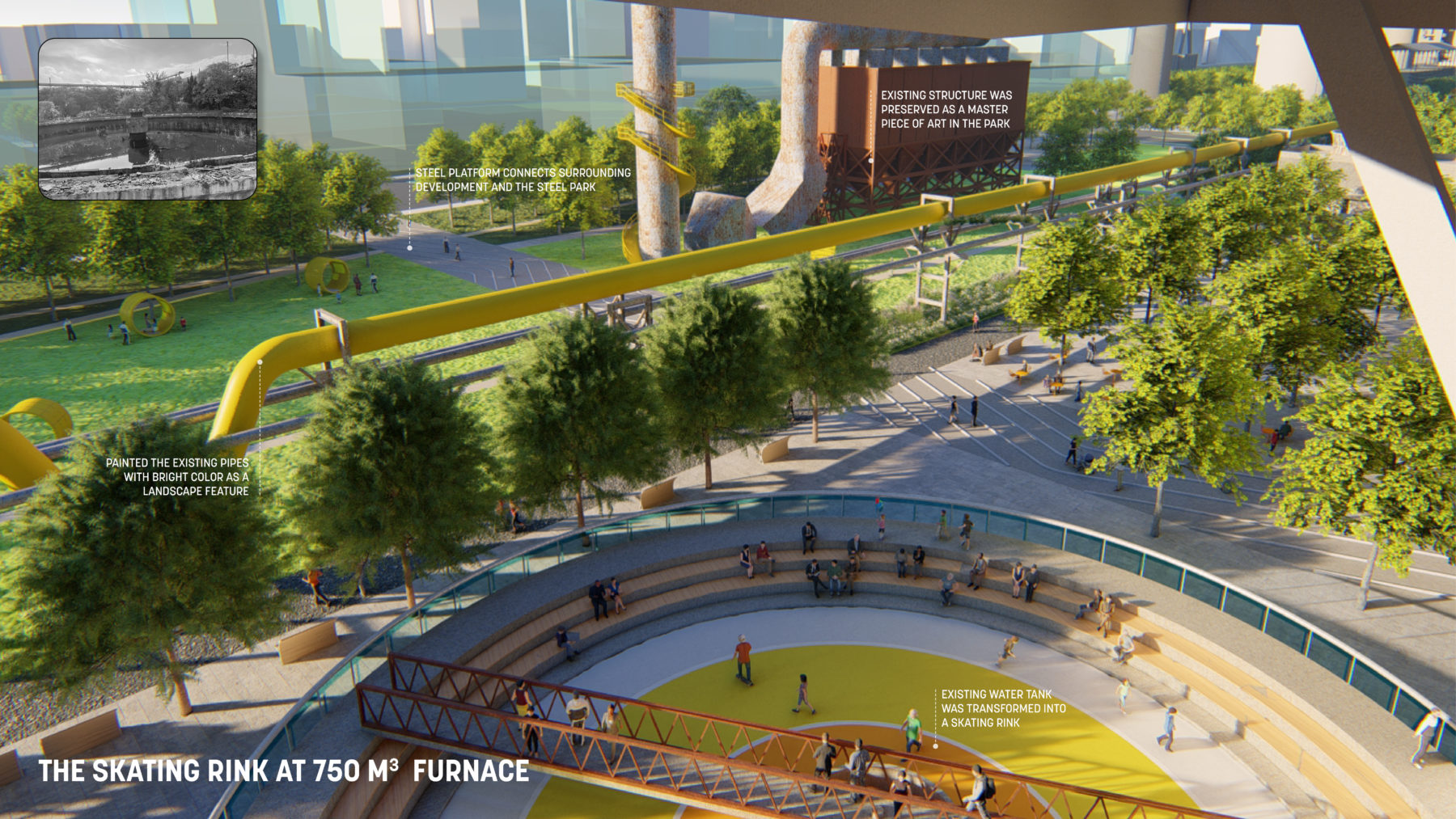
Urban Wildness Garden showcase how industrial facilities dissolve in nature over time.
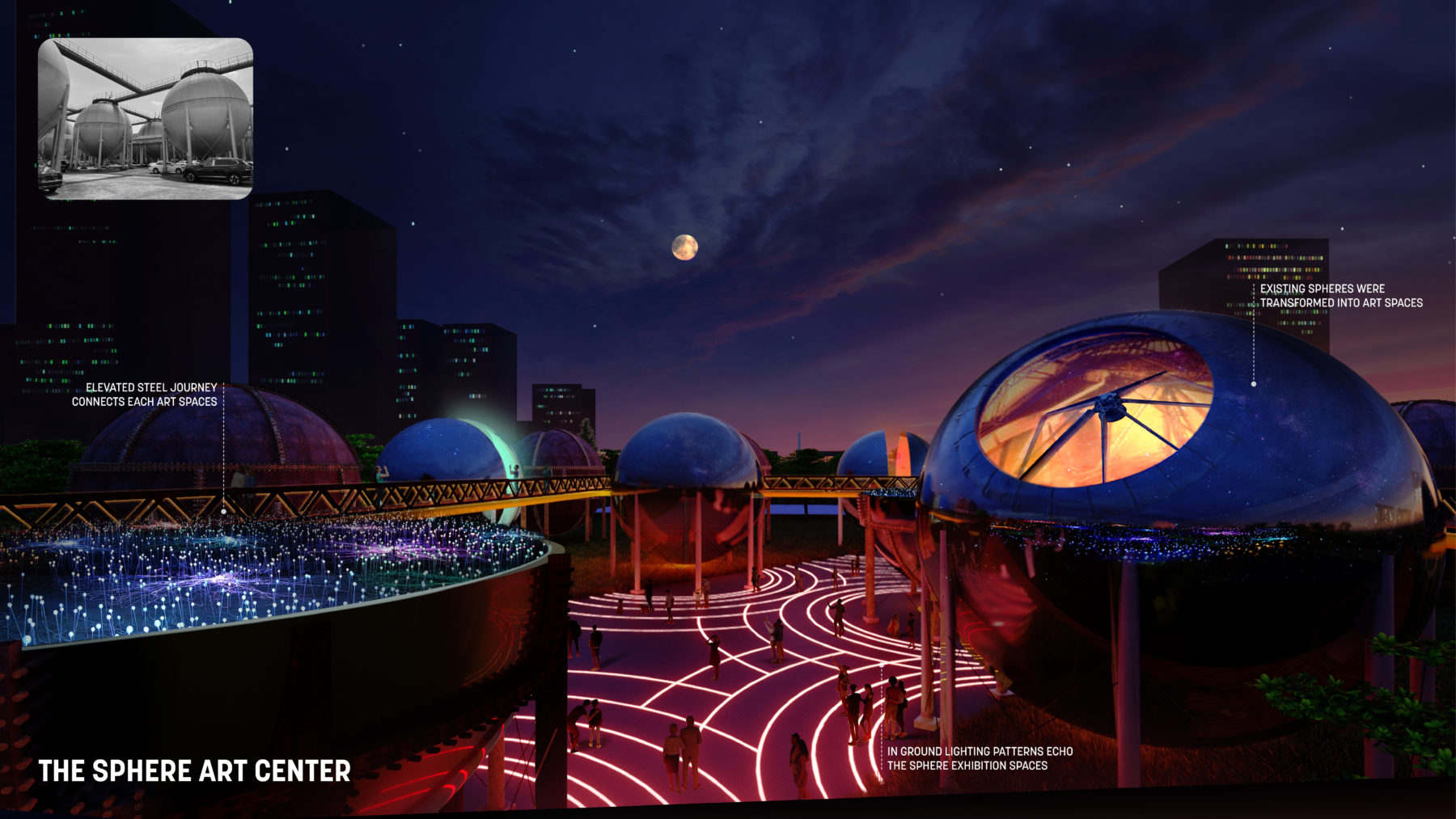
Sphere Art Center transformed from preserved sphere tank area.
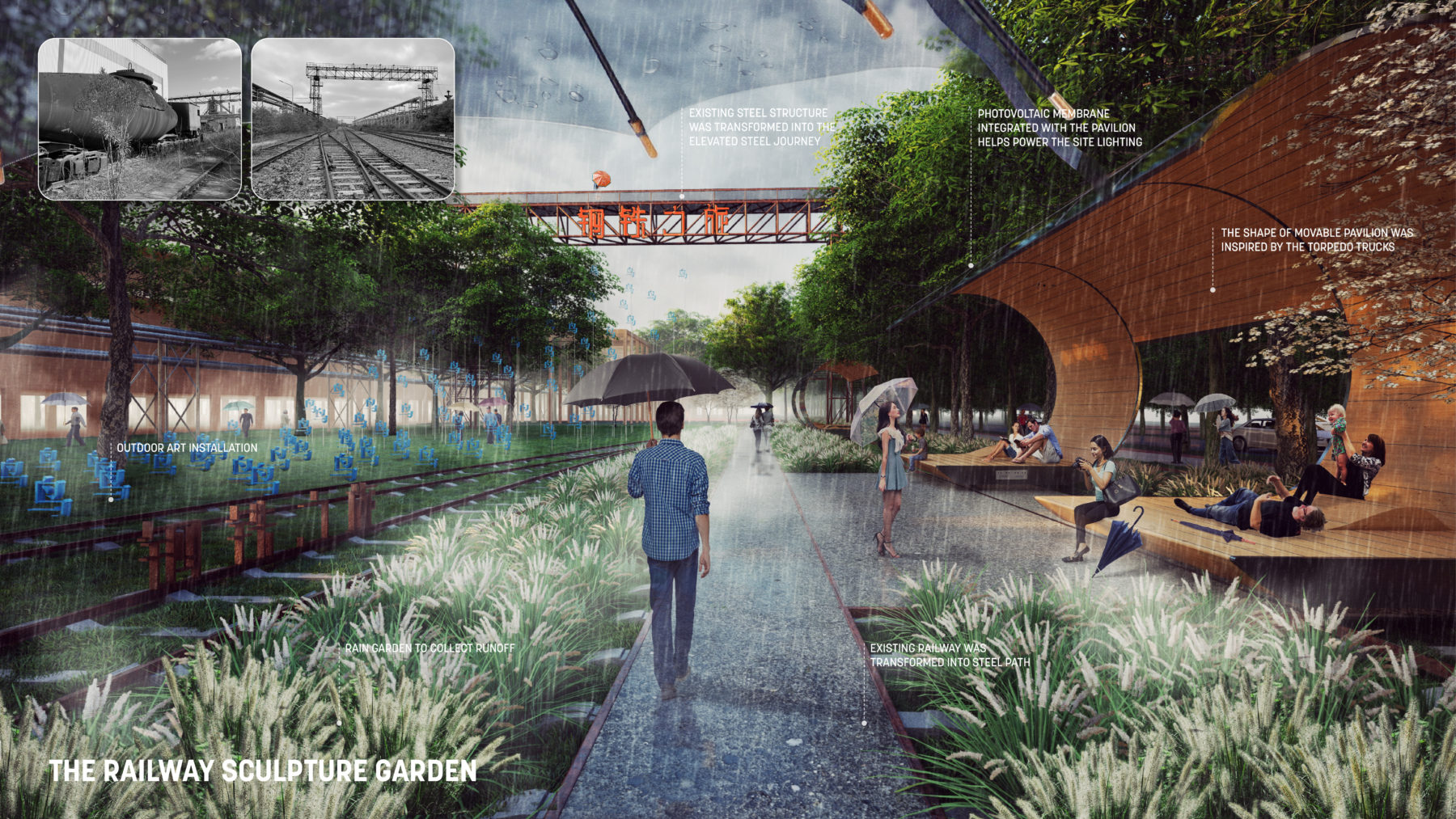
Art Garden along preserved railway over an eliminated tertiary road.
Urban Wildness Garden showcase how industrial facilities dissolve in nature over time.
Sphere Art Center transformed from preserved sphere tank area.
Art Garden along preserved railway over an eliminated tertiary road.
Create the main urban axis to play a critical role in people’s daily life
- Increase the scale of the park. By moving most of the proposed development programs away from the park, the plan allows more industrial remnants to remain, more green spaces and less shade from buildings, to create a main open space axis for the new district. The towers in the nearby development parcels are arranged to the far side, to allow for more sunlight into the park, providing the community a comfortable outdoor experience.
- Refine traffic system. With the help of a series of traffic organization measures informed by traffic analysis of the larger district, the plan eliminates ten cross streets in the district master plan, promotes public transportation and slow traffic, and proposes five land bridges over primary and secondary roads to provide more continuous experience and higher wildlife habitat value. Its road design also allows flexibility for easy transition into the driverless transportation era.
- Integrate public spaces. The plan integrates all public green spaces, streets, building setbacks, building ground floor, and second-floor corridors into a holistic public realm network by introducing land bridges, complete streets, and interwoven development and open spaces.
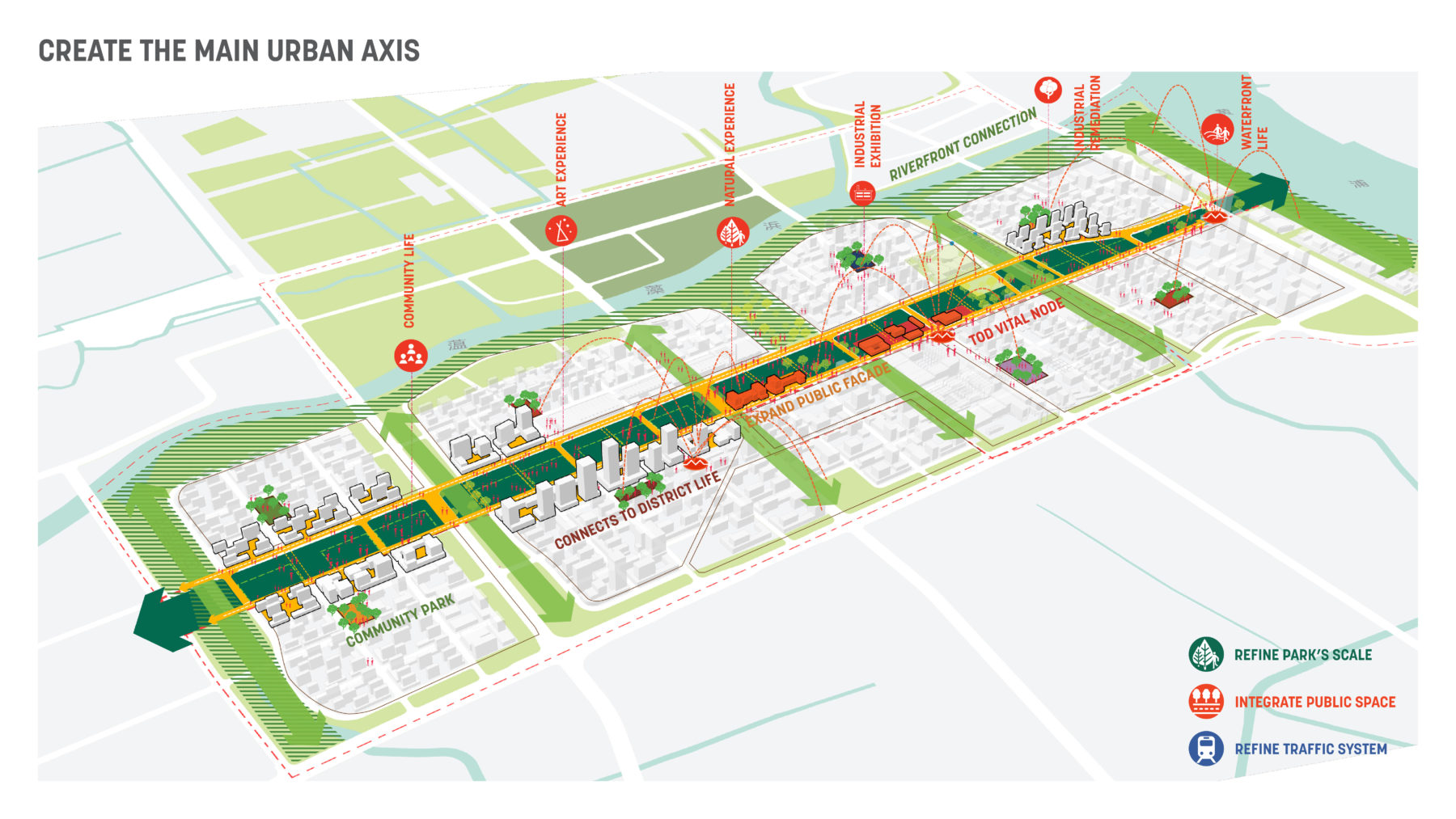
The plan will increase the scale of the park, refine the traffic system, and integrate all public green spaces, streets, building setbacks, building ground floor, and second-floor corridors into a holistic public realm network.
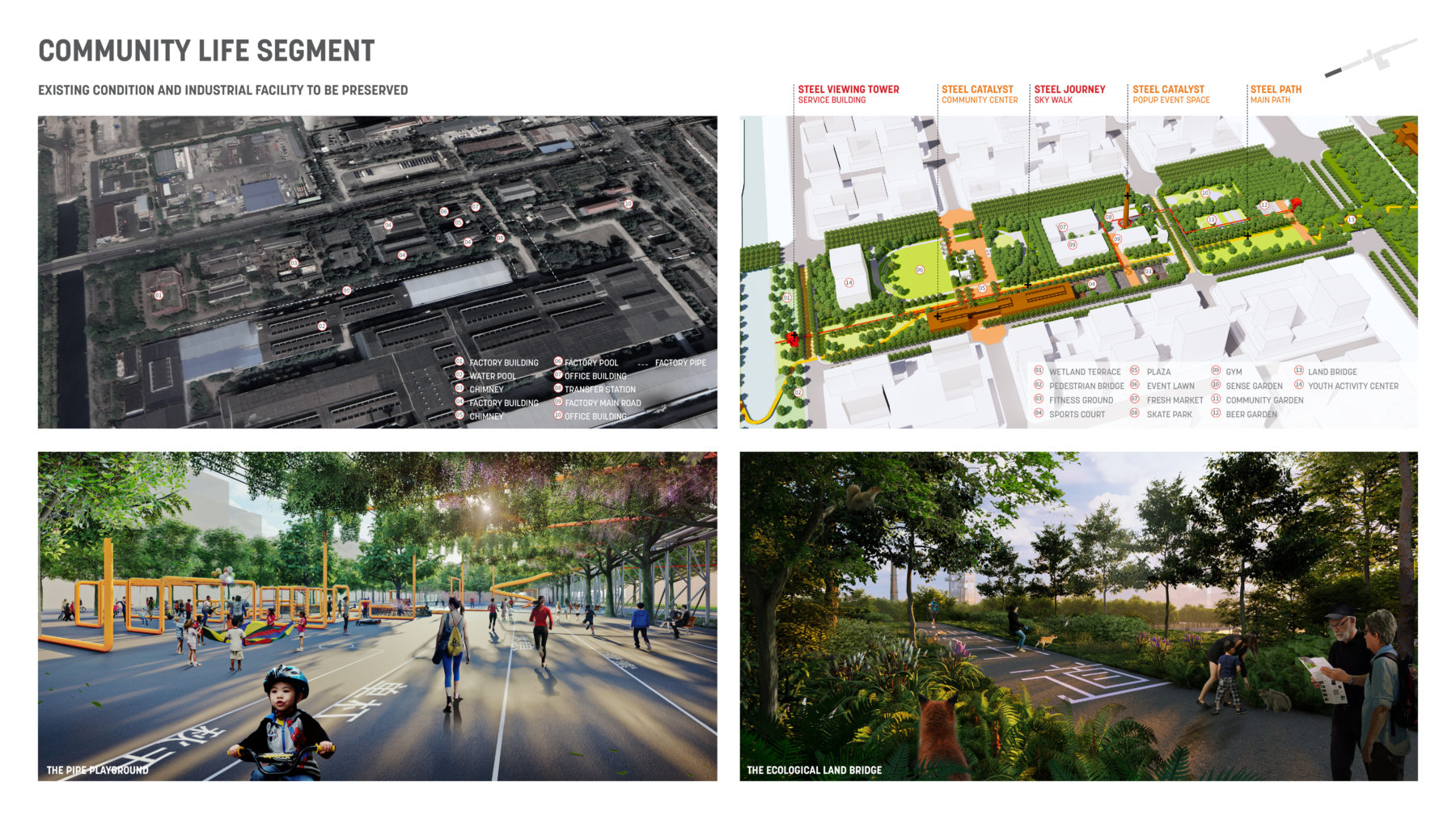
Community life segment
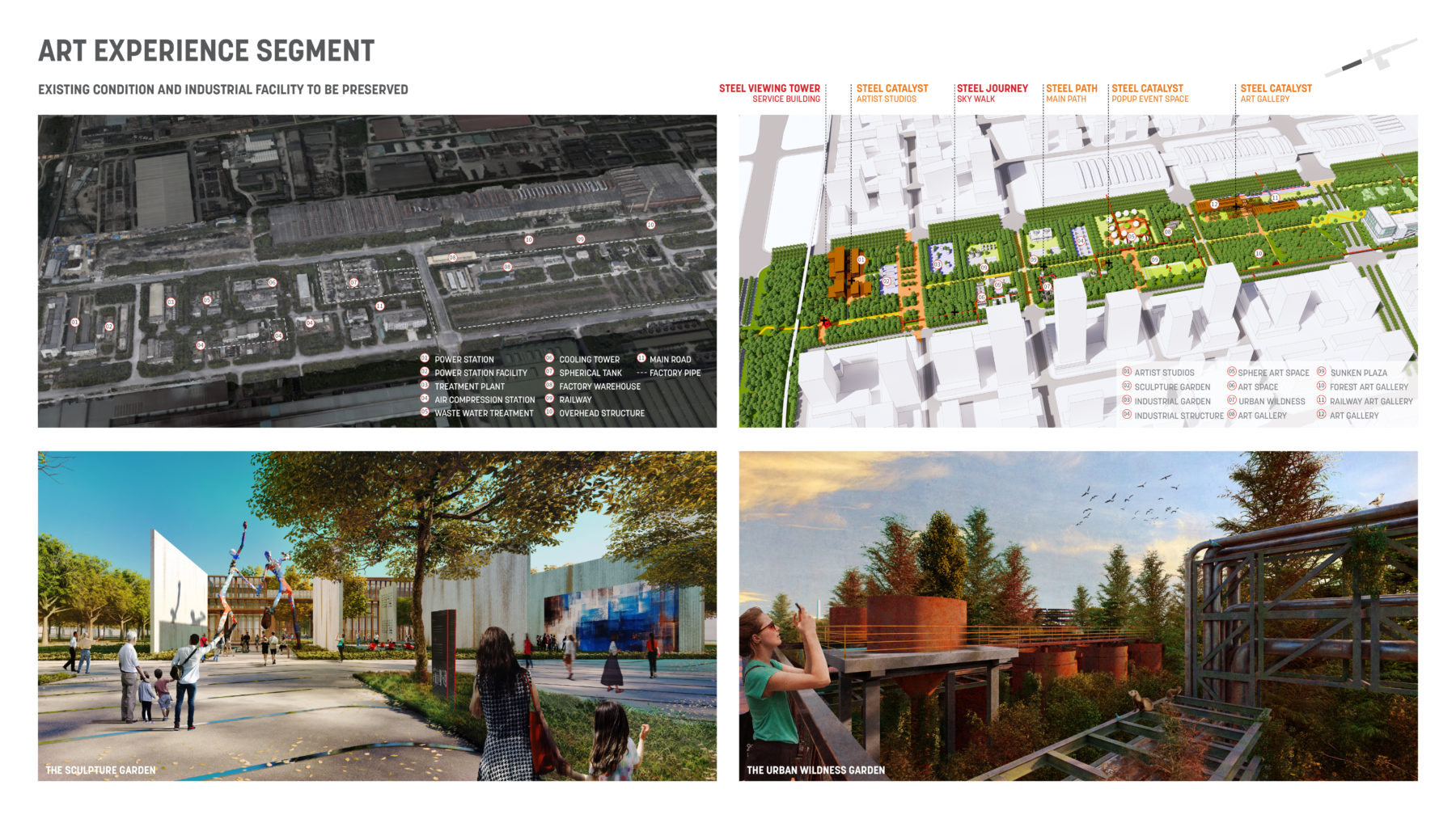
Art experience segment
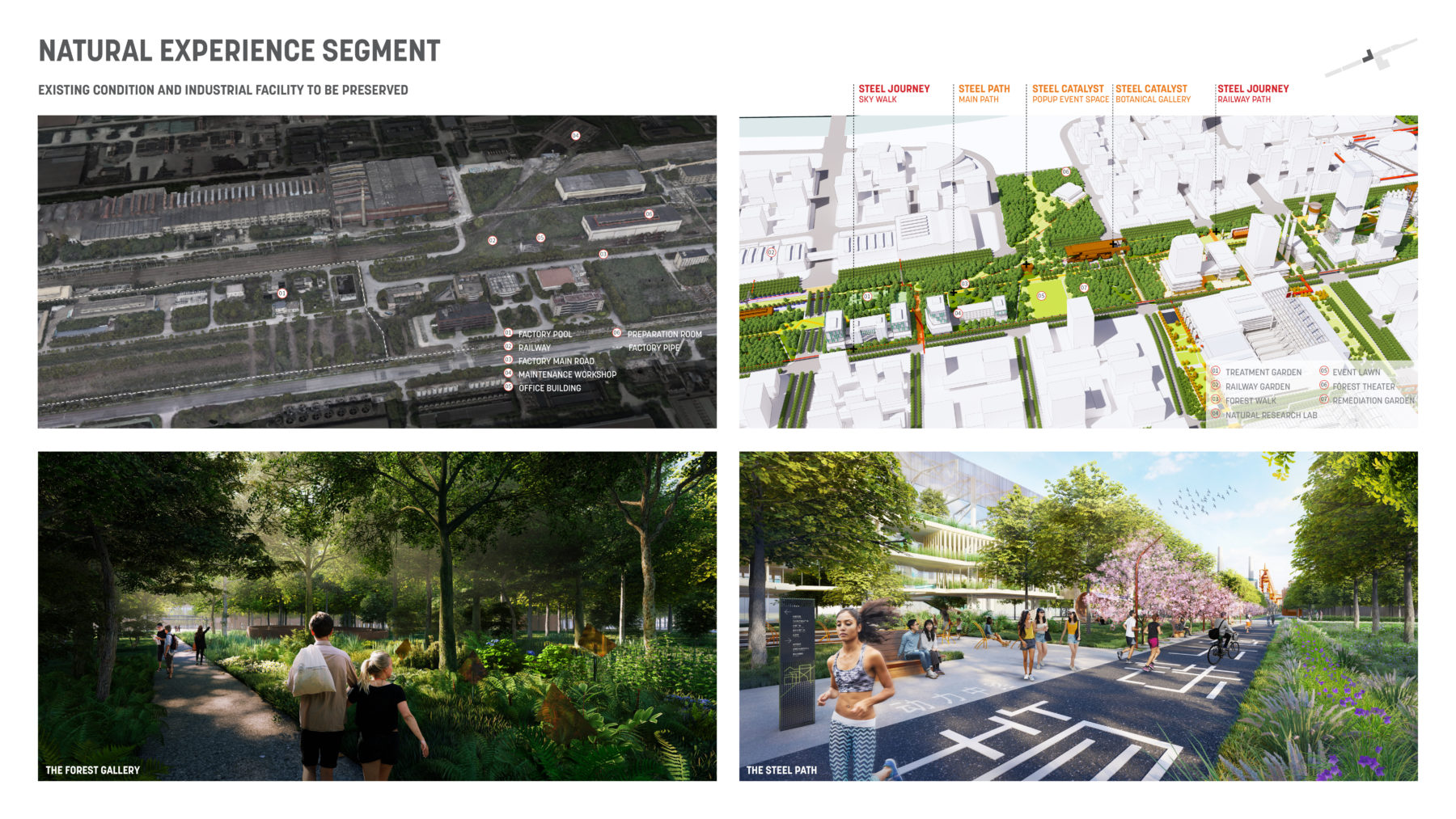
Natural experience segment
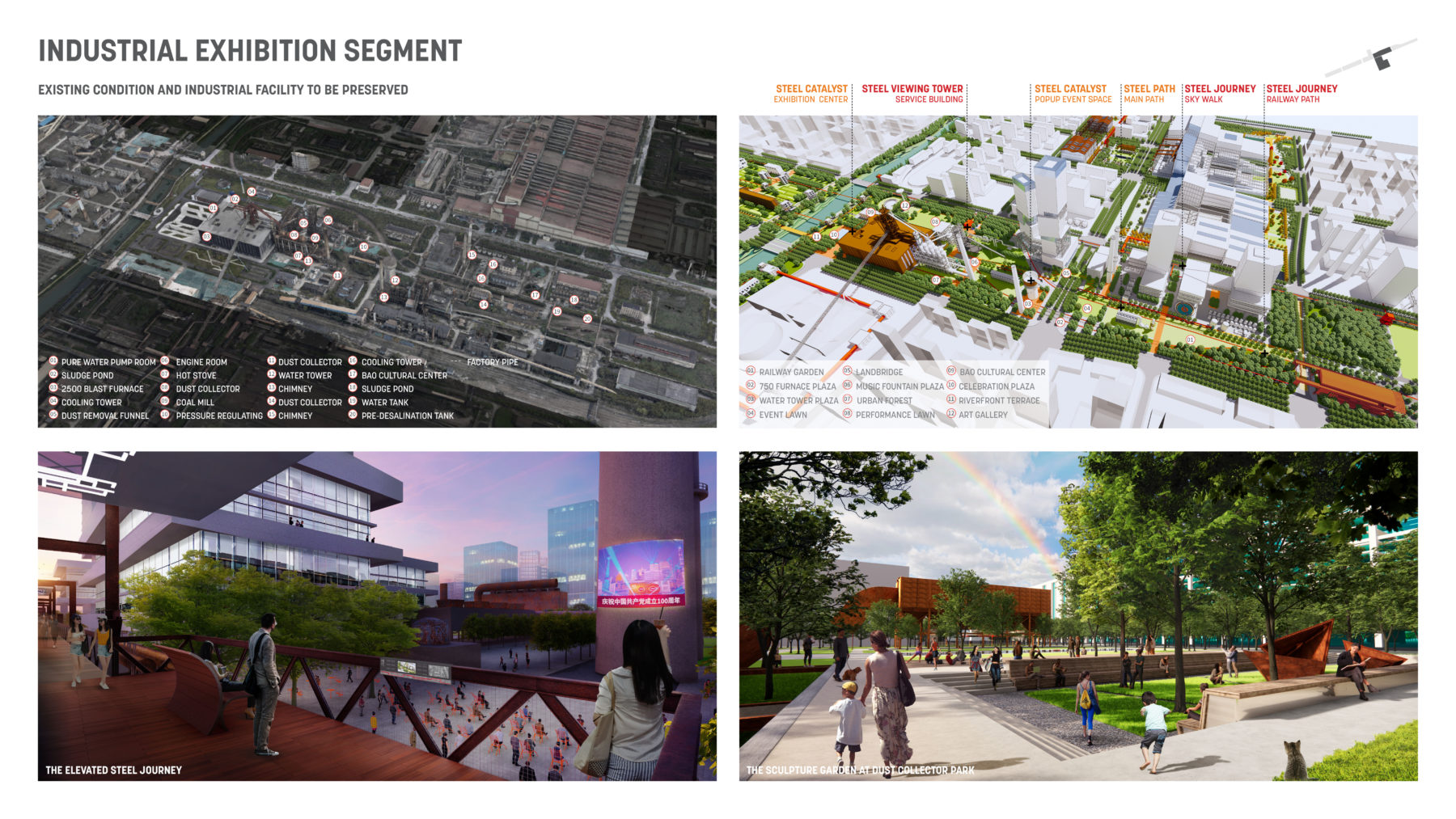
Industrial exhibition segment
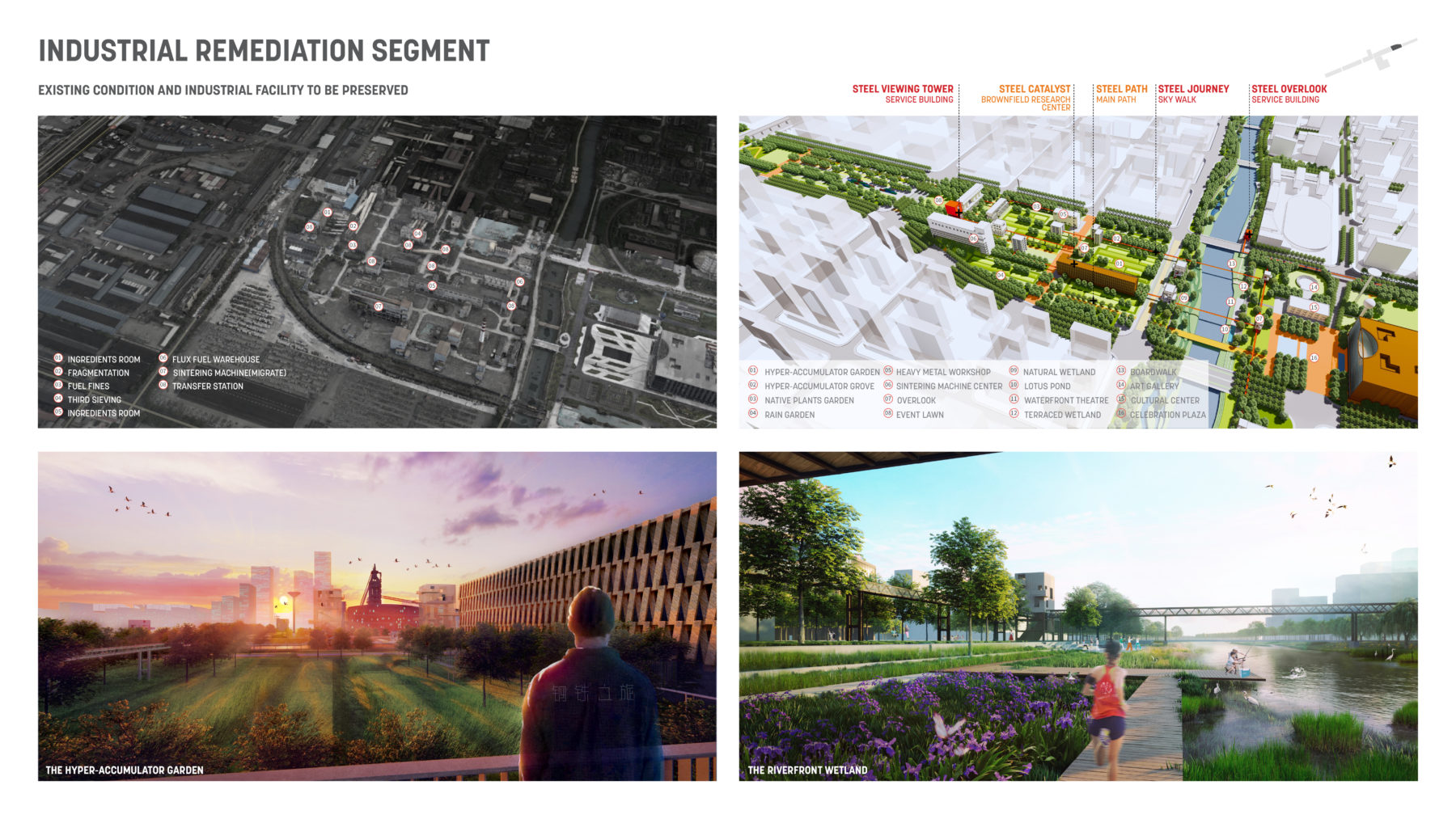
Industrial remediation segment
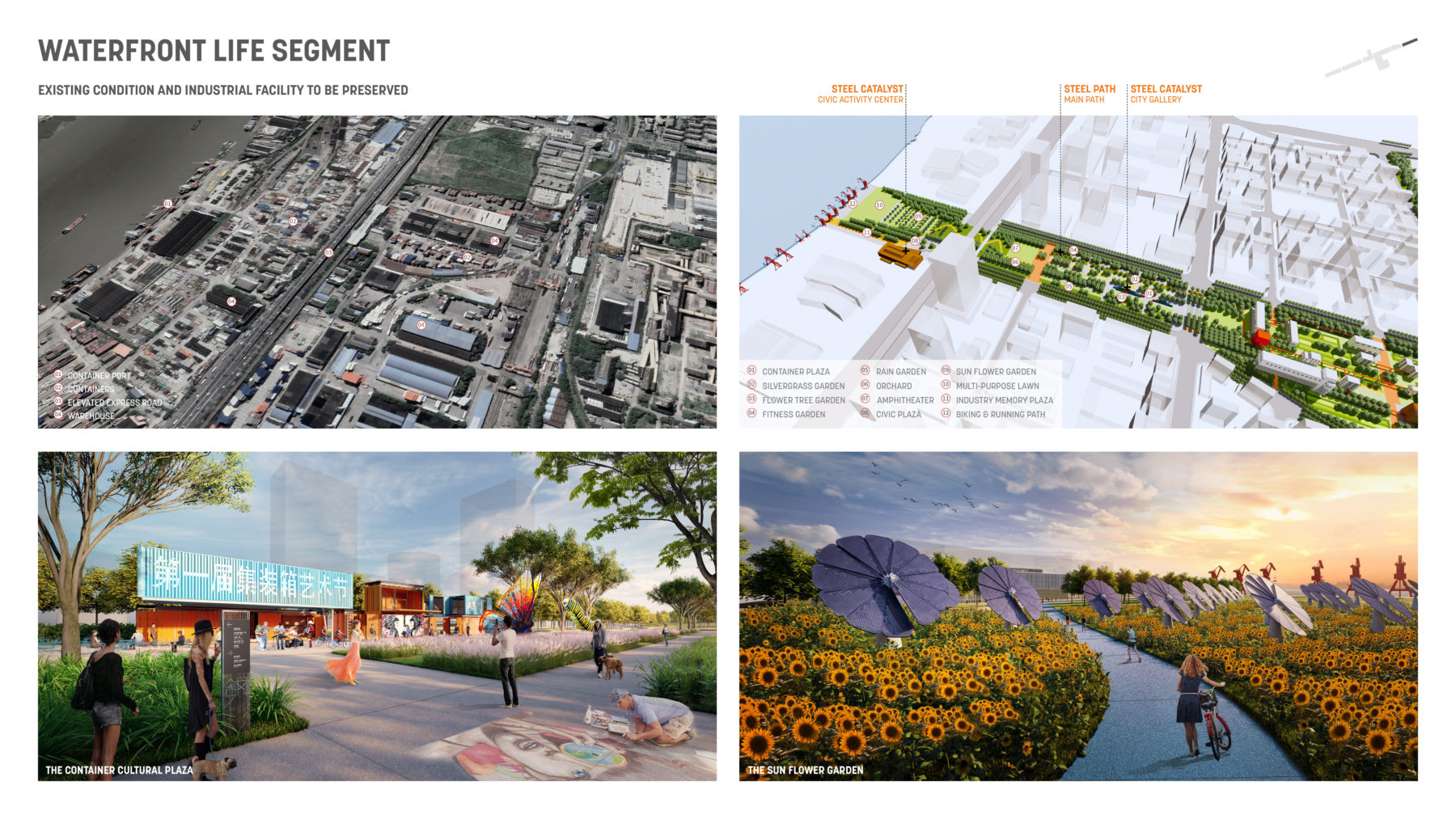
Waterfront life segment
Community life segment
Art experience segment
Natural experience segment
Industrial exhibition segment
Industrial remediation segment
Waterfront life segment
Plan Implementation
Such an ambitious project needs to be implemented in phases. Informed by the existing soil contamination and fragmented vegetation in monoculture, the park will be constructed in phases coupled with the progress of eco-restoration and the development in the district. The plan is to complete an interconnected public realm system and a mature innovation district by 2055.
The design has won the first place of the park design competition and been well received by local authorities and stakeholders. As a new model for urban post-industrial site regeneration, Baoshan Steel Park is leading the way.
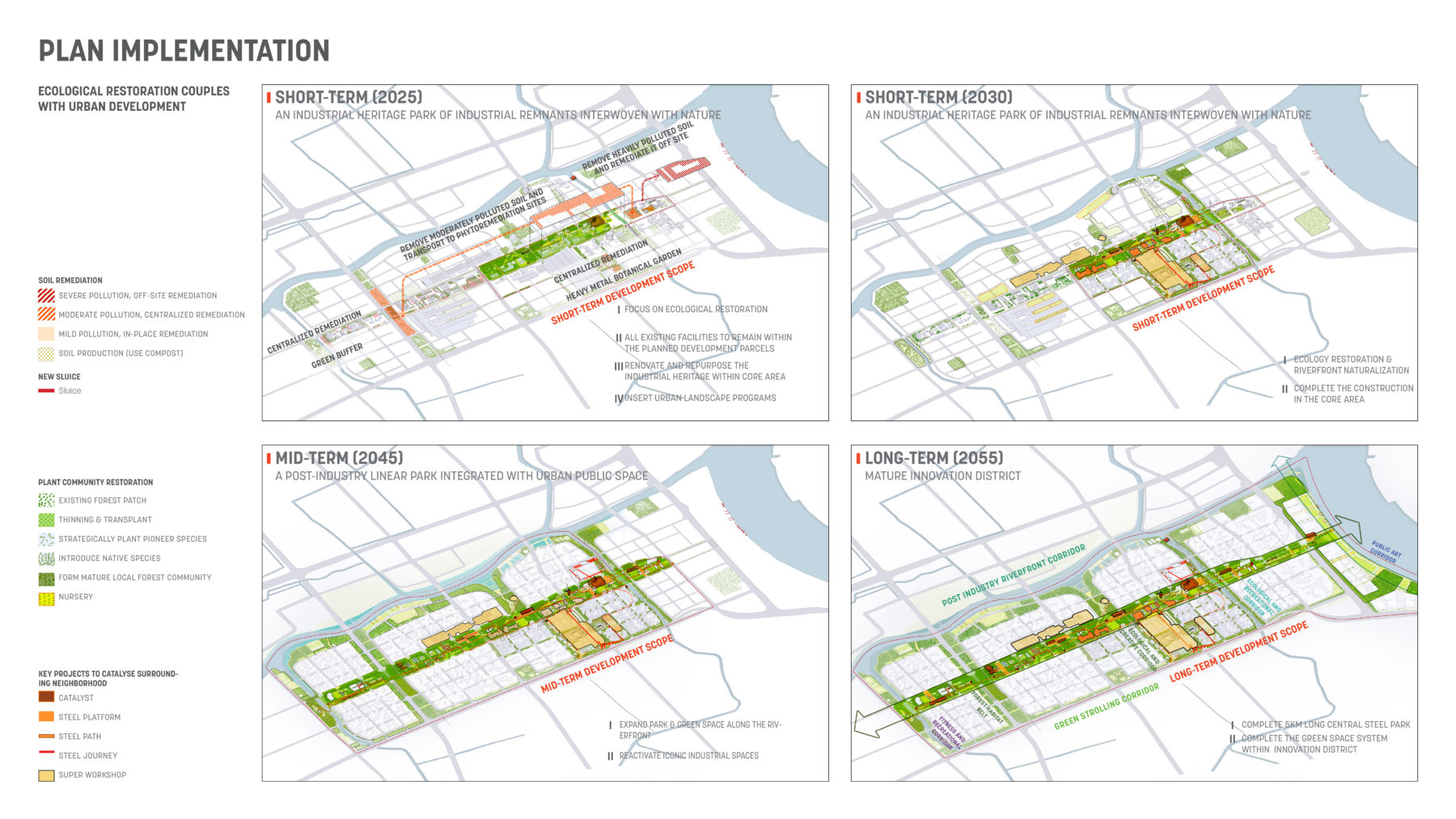
The park intends to grow over time while onsite phytoremediation and plant succession take place, building a major green infrastructure and a variety of urban habitats as well as catalyzing the new district.
